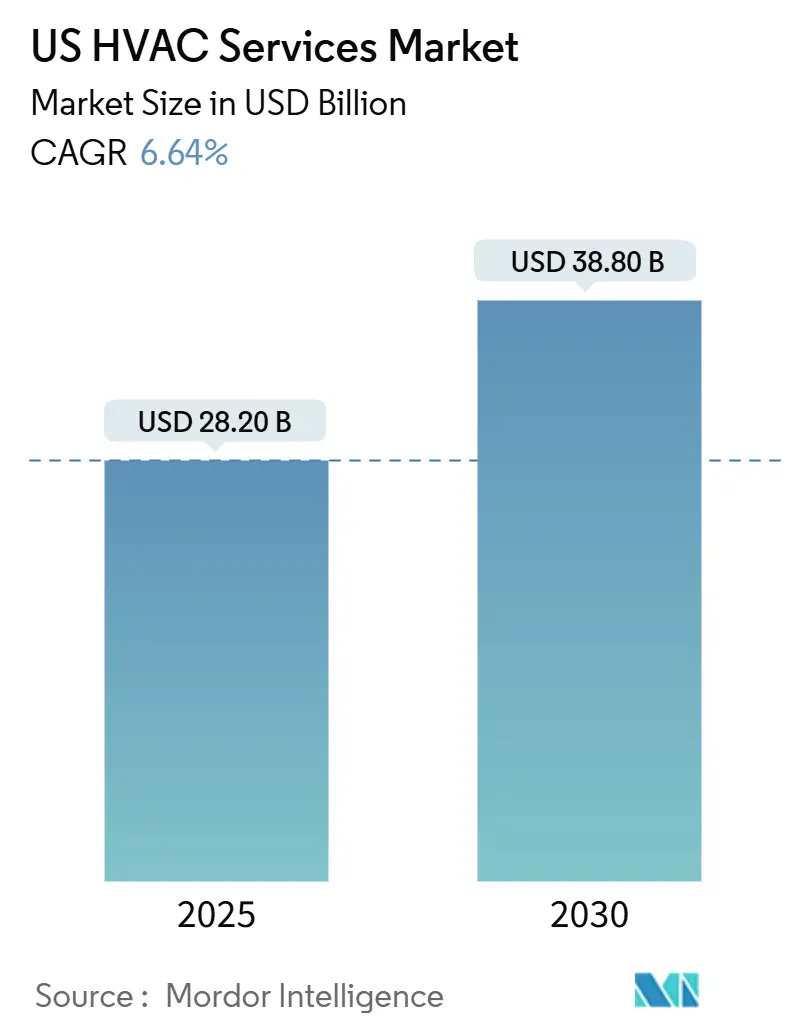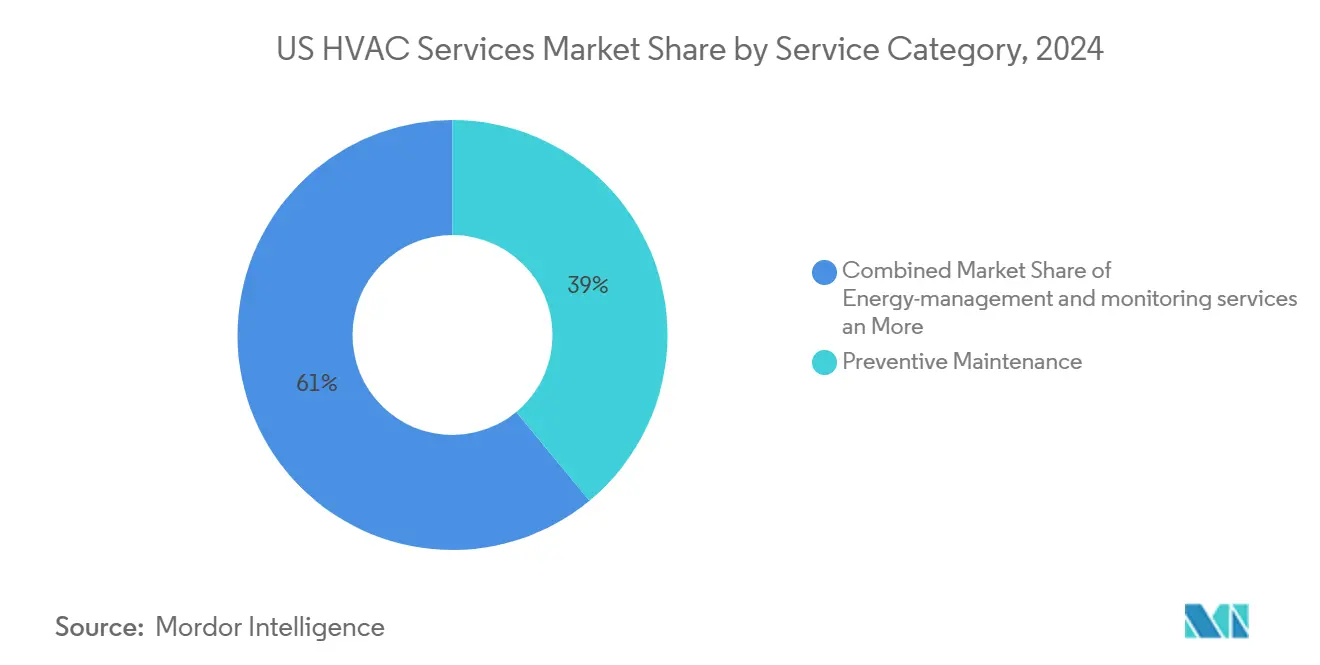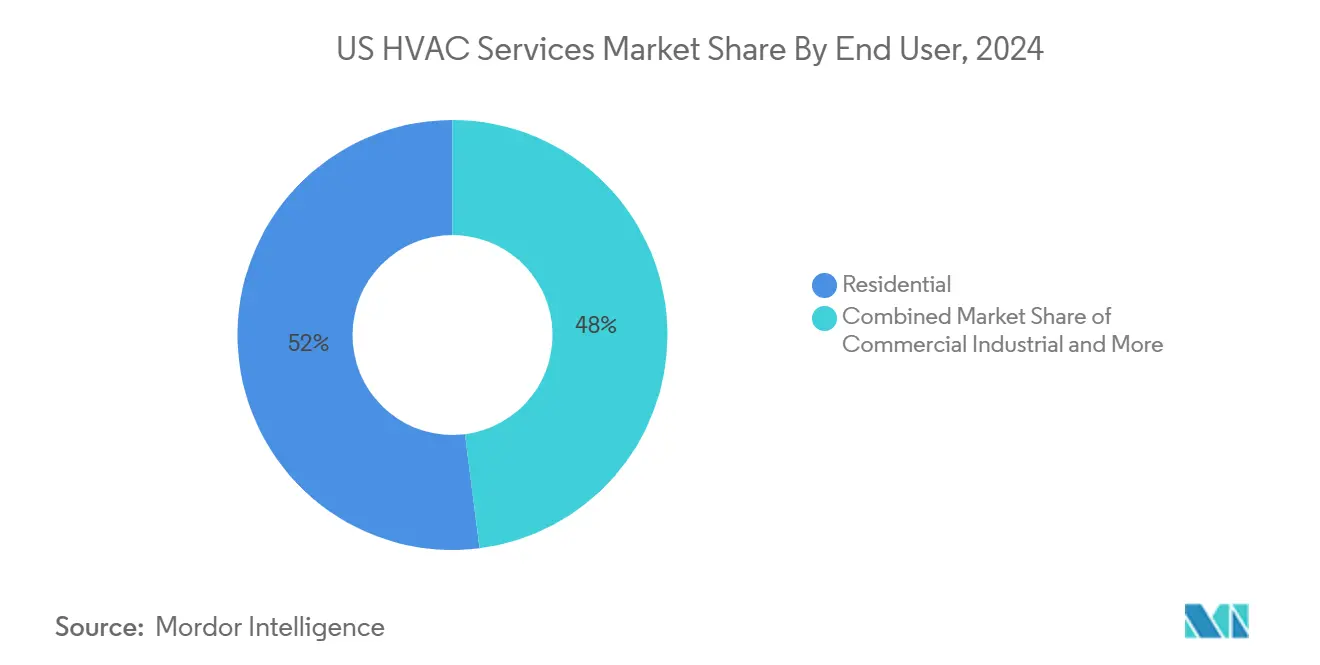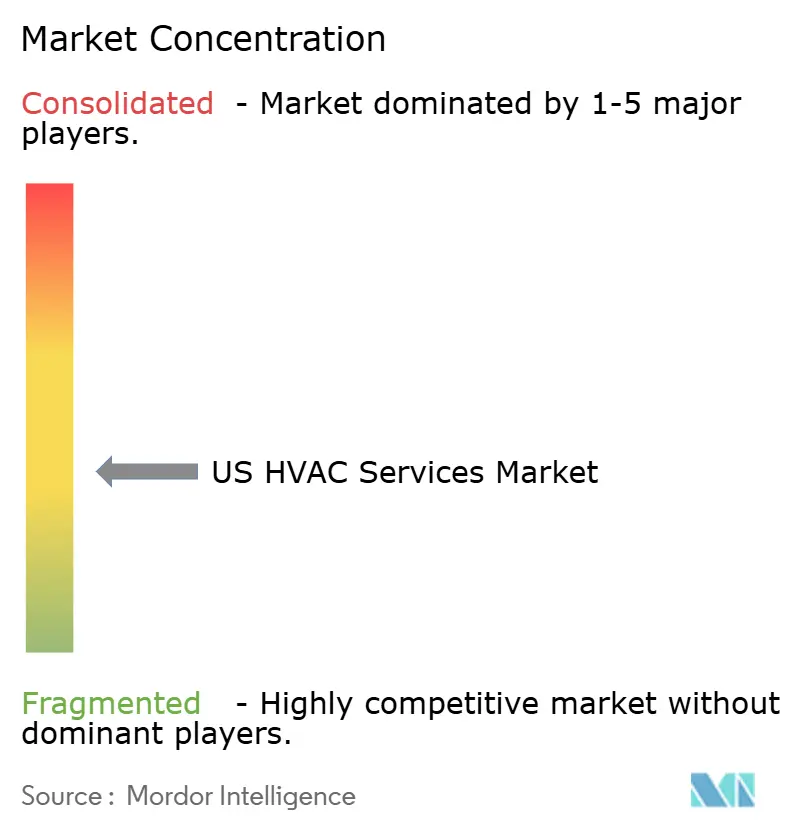
US HVAC Services Market Analysis by Mordor Intelligence
The US HVAC services market size reached USD 28.2 billion in 2025 and is projected to climb to USD 38.8 billion by 2030, advancing at a 6.6% CAGR. The expansion reflects persistent demand for replacement of aging equipment, a robust construction pipeline, and sustained policy incentives that lower the cost of energy-efficient upgrades. Construction starts rose 9.9% month-over-month in April 2025, reinforcing a solid flow of installation contracts across commercial, residential, and industrial projects. Federal rebates under the Inflation Reduction Act, paired with state-level incentives, continue to stimulate homeowner retrofits and heat-pump adoption . Parallel shifts toward smart building controls and lower-GWP refrigerants are creating compliance-driven service opportunities that lift the recurring revenue mix. At the same time, a persistent shortage of skilled technicians tightens labor supply, lifts wages, and pressures small contractors, a dynamic that supports consolidation plays by capital-rich operators. [1]U.S. Bureau of Labor Statistics, “Heating, Air Conditioning, and Refrigeration Mechanics and Installers,” bls.gov
Key Report Takeaways
- By end user: The residential segment held 52% of the US HVAC services market share in 2024, while the industrial segment is forecast to expand at a 7.9% CAGR through 2030.
- By service category: Preventive maintenance contracts captured 39% revenue in 2024; energy-management services are projected to post the fastest growth at an 8.2% CAGR.
- By system type: Cooling/air-conditioning services accounted for 41% of the US HVAC services market size in 2024; building-management and automation services are set to increase at a 9.1% CAGR to 2030.
- By contract model: Recurring service agreements commanded 55% revenue in 2024 and are anticipated to grow at an 8.3% CAGR, underscoring the shift toward predictable OPEX budgeting.
- By region: The South region led with 38% share of the US HVAC services market size in 2024 and is advancing at a 7.2% CAGR, supported by population growth and rising cooling-degree days
US HVAC Services Market Trends and Insights
Drivers Impact Analysis
| Driver | (~) % Impact on CAGR Forecast | Geographic Relevance | Impact Timeline |
|---|---|---|---|
| Growth in construction activity | +1.2% | South and West hubs as well as national institutional builds | Medium term (2-4 years) |
| Large installed base of aging equipment | +1.8% | Higher concentration in Northeast and Midwest | Long term (≥ 4 years) |
| Stricter energy-efficiency standards | +0.9% | Early-adoption states such as California and New York | Medium term (2-4 years) |
| Expansion of smart/IoT-enabled service models | +1.1% | Urban commercial clusters nationwide | Long term (≥ 4 years) |
| IRA electrification incentives | +0.8% | National, with stronger pull in moderate-income home segments | Short term (≤ 2 years) |
| Private-equity roll-ups | +0.6% | Fragmented regional contractor networks | Medium term (2-4 years) |
| Source: Mordor Intelligence | |||
Growth in Construction Activity
A 9.9% jump in nonresidential starts during April 2025 demonstrates that elevated materials costs have not derailed project pipelines, particularly in data centers, health care, and education facilities. The expansion funnels steady installation and commissioning work into the US HVAC services market, then converts into long-tail maintenance revenue once operations commence. As public construction outpaces private builds, service providers note a surge in government office retrofits, while data-center investment pushes premium demand for precision cooling. Contractors leveraging multi-trade capabilities position themselves for bundled mechanical-plus-controls scopes, reinforcing cross-sell potential in the US HVAC services market.
Large Installed Base of Aging HVAC Equipment
More than 90% of US households rely on equipment approaching the end of typical 15–20 year life cycles, creating predictable retrofit workstreams. On the commercial side, deferred upgrades are compounded by the impending phase-down of R-410A, which raises maintenance costs and accelerates replacement decisions.[2]U.S. Environmental Protection Agency, “Frequent Questions on the Phasedown of Hydrofluorocarbons,” epa.gov Service providers that combine refrigerant conversion expertise with energy-performance contracting secure multi-year engagements. In turn, those agreements lock in recurring revenue and boost wallet share within the US HVAC services market.
Stricter Federal & State Energy-Efficiency Standards
California’s mandatory performance benchmarking for buildings over 50,000 ft² and similar state initiatives elevate demand for diagnostic audits, controls retro-commissioning, and high-SEER equipment. Federal credits of up to USD 3,200 per year further improve net payback for owners. Providers that can integrate ASHRAE Guideline 13 compliance into design-build scopes gain a technical edge. The result is a tailwind that lifts service backlogs and magnifies premium pricing power across the US HVAC services market.
Expansion of Smart/IoT-Enabled Service Models
Connected sensors, cloud-based analytics, and hardware-as-a-service financing give building operators granular control over runtime, fault detection, and predictive maintenance. Contractors that deploy remote diagnostics shorten truck rolls and reduce downtime, which aligns incentives under performance-based contracts. The Department of Energy targets a 30% cut in HVAC energy consumption through advanced controls, validating the value proposition of tech-centric offerings. This transformation shifts the competitive narrative from wrench-time to data-driven outcomes, deepening service stickiness inside the US HVAC services market.
Restraints Impact Analysis
| Restraint | (~) % Impact on CAGR Forecast | Geographic Relevance | Impact Timeline |
|---|---|---|---|
| Shortage of certified HVAC technicians | -1.4% | National, acute in rural and secondary geographies | Long term (≥ 4 years) |
| Rising refrigerant transition and compliance costs | -0.8% | National, higher burden on small contractors | Short term (≤ 2 years) |
| Source: Mordor Intelligence | |||
Shortage of Certified HVAC Technicians
Roughly 42,500 openings emerge each year, yet graduation pipelines lag the needs of new construction and retrofit workloads. Median wages hit USD 57,300 in 2023, lifting operating costs and eroding margins, especially for small businesses. Public-sector apprenticeship programs aim to fill the gap, but required lead times mean hiring remains a strategic bottleneck through the decade. Firms that build in-house academies and defined career ladders enjoy higher retention and mitigate this drag on the US HVAC services market.
Rising Refrigerant Transition & Compliance Costs
The EPA Technology Transition rule effective January 2025 mandates A2L refrigerants, forcing contractors to invest in specialized recovery machines, non-sparking tools, and retraining programs. Smaller operators absorb higher working-capital needs as R-410A components rise in cost and A2L parts carry premium pricing. Compliance timelines vary by state, adding administrative friction for multi-state service firms. In consequence, margin compression weighs on the tail of the US HVAC services market growth curve until supply chains mature.
Segment Analysis
By Service Category: Maintenance Contracts Drive Recurring Revenue
Preventive maintenance contracts held 39% of 2024 revenue, underscoring owner preference for predictable cost management and uptime protection. Commercial portfolios now embed equipment analytics that schedule service visits based on real-time runtime data rather than calendar intervals, which increases contract renewal rates and raises average revenue per unit. Energy-management and monitoring services are expanding at an 8.2% CAGR, fueled by compliance pressures and the need to optimize load profiles under dynamic utility tariffs. Contractors that couple monitoring with performance guarantees deepen wallet share inside the US HVAC services market.
Installation contracting remains correlated with construction spending, while emergency repair services thrive during peak-load events and extreme weather. Design engineering scopes are broadening to include decarbonization road-mapping and lifecycle cost analysis. Owners increasingly bundle mechanical, controls, and sustainability audits under a single provider, elevating the strategic relevance of full-service firms. As those contracts typically span three to five years, they stabilize cash flow and reinforce client captivity, which strengthens competitive positions across the US HVAC services market.

Note: Segment shares of all individual segments available upon report purchase
By System Type Served: Controls Integration Accelerates Growth
Cooling services accounted for 41% revenue in 2024, a figure that continues to climb as cooling-degree days trend upward in nearly all US climate zones.[3] Building-management system (BMS) and automation services compose the fastest-growing slice at a 9.1% CAGR, aligned with rising demand for fault detection and data-driven optimization. Heating services exhibit pronounced regional differences; heat-pump adoption is growing fastest in northern states where electrification incentives narrow the cost premium.
Ventilation and indoor-air-quality (IAQ) scopes benefit from occupant-health imperatives in schools and commercial offices. Refrigeration services face higher compliance spend due to the switch to A2L refrigerants, which is prompting specialized tool investments. Thermal-energy-storage retrofits, validated by California demonstrations that achieved 13% savings and 46% peak-load shifting, are emerging as ancillary revenue streams for performance-oriented contractors.[4]California Energy Commission, California Energy Commission, “Thermal Energy Storage System for Packaged HVAC Systems,” energy.ca.govAs controls converge with mechanical systems, service providers capture incremental integration fees and create differentiated bundles within the US HVAC services market.
By End User: Industrial Segment Leads Growth Acceleration
The residential channel held the largest revenue pool at 52% in 2024. Federal and utility incentives compress payback for heat-pump replacements, encouraging homeowners to upgrade rather than repair legacy units. In contrast, the industrial segment is on track for 7.9% CAGR through 2030, propelled by data-center expansion, on-shoring manufacturing investments, and specialized clean-room environments that demand high-reliability cooling. Data-center spending alone is forecast to top USD 293.09 billion in 2024, sustaining premium-rate service contracts that contribute outsized margin in the US HVAC services market.
Commercial real estate maintains steady demand as building owners retrofit for energy-code compliance and tenant comfort. Institutional buyers in education and health care prioritize IAQ and resiliency, fostering adoption of advanced filtration, UV-GI, and redundant system architectures. Residential growth benefits from aging housing stock dating to the 1990s and earlier, which raises replacement propensity. Industrial and commercial clients grant multi-facility agreements that bundle mechanical scope with controls integration, thereby deepening the service addressable base inside the US HVAC services market.

Note: Segment shares of all individual segments available upon report purchase
By Contract Model: Recurring Agreements Dominate Market Structure
Recurring service agreements captured 55% share in 2024 and will rise at an 8.3% CAGR, reflecting the shift toward outcome-based relationships. Building owners favor predictable OPEX and reduced emergency repair risk; in response, contractors build subscription models that bundle preventive maintenance, parts allowances, and 24/7 remote diagnostics. Energy-as-a-service variants go a step further, tying contractor compensation to measured energy reductions.
Project-based contracts remain relevant for large facility additions and code-driven retrofits. Yet as IoT penetration deepens, owners prefer data-sharing frameworks that reward continuous performance improvement. Contractors with dedicated analytics teams leverage insights to upsell retrofit recommendations, thereby increasing revenue per contract cycle and cementing stickiness within the US HVAC services market.
Geography Analysis
The South commands 38% of 2024 revenue thanks to population inflows, elevated cooling needs, and a pro-growth construction climate. Average cooling-degree days in Texas, Florida, and Georgia continue to rise, translating into heavier runtime hours and higher maintenance frequencies. Public-sector construction in these states adds demand for large-scale institutional projects that require complex mechanical scopes. The West follows, bolstered by data-center clusters in Arizona and Oregon, yet construction volatility creates lumpy order cycles that reward contractors with flexible workforces.
The Northeast presents a different profile, with an aging building stock that drives retrofit opportunities intertwined with stringent energy-performance mandates in New York and Massachusetts. Owners deploy phased upgrade programs combining heat-pump conversions and controls retrofits, which lifts multi-year service backlogs. Midwest demand centers on industrial maintenance for manufacturing, food processing, and logistics facilities, complemented by household heat-pump incentives that temper heating equipment seasonality.
Regional construction spending patterns reveal public projects advancing 4.7% year-over-year versus 2.3% for private builds, with healthcare and education dominating bid calendars. Contractors that maintain cross-regional footprints arbitrage cyclical swings and share technician pools, an increasingly strategic move given tight labor supply. Consequently, the US HVAC services market exhibits nuanced regional dynamics that favor diversified operators able to balance contract exposure.
Competitive Landscape
The US HVAC services market remains moderately fragmented, although consolidation is accelerating. EMCOR Group delivered USD 14.6 billion revenue for 2024, with 24% attributable to recurring building services and 15.8% overall growth, leveraging scale to secure multi-trade, high-complexity scopes. Comfort Systems USA reported USD 7.0 billion revenue and a USD 5.99 billion backlog, providing strong visibility into 2026 earnings streams.
Regional specialists retain competitive edges in customer intimacy and rapid dispatch, though rising compliance costs and technician wages squeeze their margins. Private-equity sponsors continue to assemble multi-state platforms that integrate acquisitions onto centralized ERP and field-service-management software, improving fleet utilization and parts procurement. Technology adoption is quickly becoming the separator between premium and commodity service providers; firms that deploy IoT monitoring, mobile diagnostics, and AI-driven dispatch reduce truck rolls and boost first-time-fix rates.
Labor scarcity shapes competitive dynamics as intensely as capital access. Employers invest in in-house academies, mentorship programs, and signing bonuses to secure scarce technicians. Firms that maintain higher retention not only lower recruitment costs but also protect institutional knowledge that underpins high first-time-fix ratios. In parallel, the refrigerant transition raises the barrier to entry by necessitating tool upgrades and A2L handling certifications. This cumulative complexity encourages strategic alliances and specialty subcontractor networks inside the US HVAC services market.
US HVAC Services Industry Leaders
EMCOR Services
Comfort Systems USA
Service Logic
ABM Technical Solutions (HVAC)
Southland Industries
- *Disclaimer: Major Players sorted in no particular order

Recent Industry Developments
- April 2025: EMCOR Group posted USD 14.6 billion 2024 revenue, up 15.8%, capitalizing on high-tech manufacturing and health-care project wins while expanding bundled energy-efficiency services.
- February 2025: Comfort Systems USA filed its 10-K showing USD 7.0 billion revenue and a USD 5.99 billion backlog, reflecting strong cross-sell momentum in mechanical and electrical scopes.
- January 2025: The EPA Technology Transition rule took effect, mandating A2L refrigerants, which spurs compliance consulting and tool-upgrade demand across contractor fleets.
- December 2024: California Energy Commission validated 13% savings and 46% peak-load shifting from thermal-energy-storage retrofits, strengthening the business case for performance-based service contracts.
Research Methodology Framework and Report Scope
Market Definitions and Key Coverage
Our study defines the United States HVAC services market as all revenue earned inside the country by licensed contractors, distributors, and OEM-affiliated service teams through the design, installation, retrofit, preventive maintenance, energy management, and emergency repair of heating, ventilation, air conditioning, refrigeration, and connected control systems that serve residential, commercial, industrial, and institutional buildings.
Sales of brand-new HVAC equipment, replacement parts sold over the counter, and purely do-it-yourself labor are excluded.
Segmentation Overview
- By Service Category
- Design and Engineering
- Installation Contracting
- Preventive Maintenance Contracts
- Emergency Repair Services
- Energy-Management and Monitoring Services
- By System Type Served
- Heating (Furnace, Boiler, Heat Pump) Services
- Cooling / Air-Conditioning Services
- Ventilation and IAQ Services
- Refrigeration Services
- Controls, BMS and Automation Services
- By End User
- Residential
- Commercial
- Industrial
- Institutional (Education, Healthcare, Govt)
- By Contract Model
- Project-Based (One-off)
- Recurring Service Agreements
- By Geography (US Census Regions)
- Northeast
- Midwest
- South
- West
Detailed Research Methodology and Data Validation
Primary Research
Mordor analysts interviewed facility managers, multi-state residential contractors, regional distributors, and code officials across the Northeast, South, Midwest, and West. These conversations corroborated unit service prices, technician productivity, contract renewal rates, and the emerging impact of Inflation Reduction Act rebate programs, thereby filling gaps left by published statistics and refining our regional weightings.
Desk Research
We began with public datasets that clarify the size of the serviced equipment pool and the cadence of replacement work, such as U.S. Census construction put-in-place tables, the Residential Energy Consumption Survey, Bureau of Labor Statistics contractor wage files, Energy Information Administration heat pump shipment reports, and Federal tax credit uptake notices. Industry guidelines and rulemakings from ASHRAE, DOE, and EPA helped us gauge service needs around refrigerant phase-downs and higher SEER standards. Trade association materials from ACCA, PHCC, AHRI, and the Building Owners and Managers Association added building-level behavioral insight. To enrich firm-level revenue splits, we tapped D&B Hoovers and news flows via Dow Jones Factiva. This list is illustrative; many additional open and paid sources informed data collection and validation.
Market-Sizing & Forecasting
A top-down model converts building stock, equipment penetration, and typical annual service spend into a demand pool, which is then counter-checked with bottom-up samples of contractor revenues and average selling price times service visit volumes. Key variables like housing starts, non-residential floor space additions, average equipment age, refrigerant compliance deadlines, and technician wage inflation drive both value and growth assumptions. Multivariate regression and scenario analysis project these inputs through 2030; anomalies surfaced during modeling trigger call-backs to respondents or revisits of source data.
Data Validation & Update Cycle
Outputs pass a three-step review: automated variance flags, peer analyst audit, and senior sign-off. We refresh each model annually, issuing interim updates when policy shocks, extreme weather, or large M&A events materially alter service demand. A last-mile check is completed just before report release.
Why Mordor's US HVAC Services Baseline Commands Reliability
Published U.S. HVAC service estimates often differ because firms mix equipment sales with labor, cover North America instead of one country, or lock assumptions before new energy efficiency rules land.
Key gap drivers include scope breadth, contract mix treatment, refresh cadence, and the depth of primary validation.
Mordor's study, anchored in 2025 contractor-only revenue and renewed every year, avoids such drift.
Benchmark comparison
| Market Size | Anonymized source | Primary gap driver |
|---|---|---|
| $28.20 B (2025) | Mordor Intelligence | - |
| $40.87 B (2025, North America) | Regional Consultancy A | Includes Canada and Mexico, combines equipment and labor, limited primary checks |
| $26.90 B (2024, U.S.) | Industry Consultancy B | Focuses on upgrade and replacement only; conservative renewal assumptions; shorter forecast span |
Taken together, the comparison shows that Mordor's disciplined service-only scope, live policy tracking, and dual-layer validation deliver a balanced, decision-ready baseline for planners and investors.
Key Questions Answered in the Report
How large is the US HVAC services market today?
The US HVAC services market size stands at USD 28.2 billion in 2025 and is on track to reach USD 38.8 billion by 2030, reflecting a 6.6% CAGR.
Which customer segment is growing fastest?
Industrial facilities, led by data centers and advanced manufacturing, are expected to post a 7.9% CAGR through 2030, outpacing residential and commercial demand.
What is driving adoption of smart HVAC service models?
Rising energy costs, stricter efficiency mandates, and federal incentives are pushing owners to deploy IoT-enabled controls that enable predictive maintenance and continuous optimization.
How are refrigerant regulations affecting service providers?
The EPA rule effective January 2025 mandates low-GWP A2L refrigerants, requiring new recovery tools, technician training, and compliance documentation, which raise capital needs and reshape service offerings.
Why are private-equity firms investing heavily in HVAC services?
Recurring maintenance contracts generate predictable cash flow, and a fragmented provider landscape offers consolidation upside, leading to Q4 2024 deal multiples as high as 16.5× EBITDA.
What strategies help contractors mitigate the technician shortage?
Building in-house training academies, partnering with apprenticeship programs, and offering career-path incentives improve recruitment and retention, safeguarding service quality and growth capacity.



